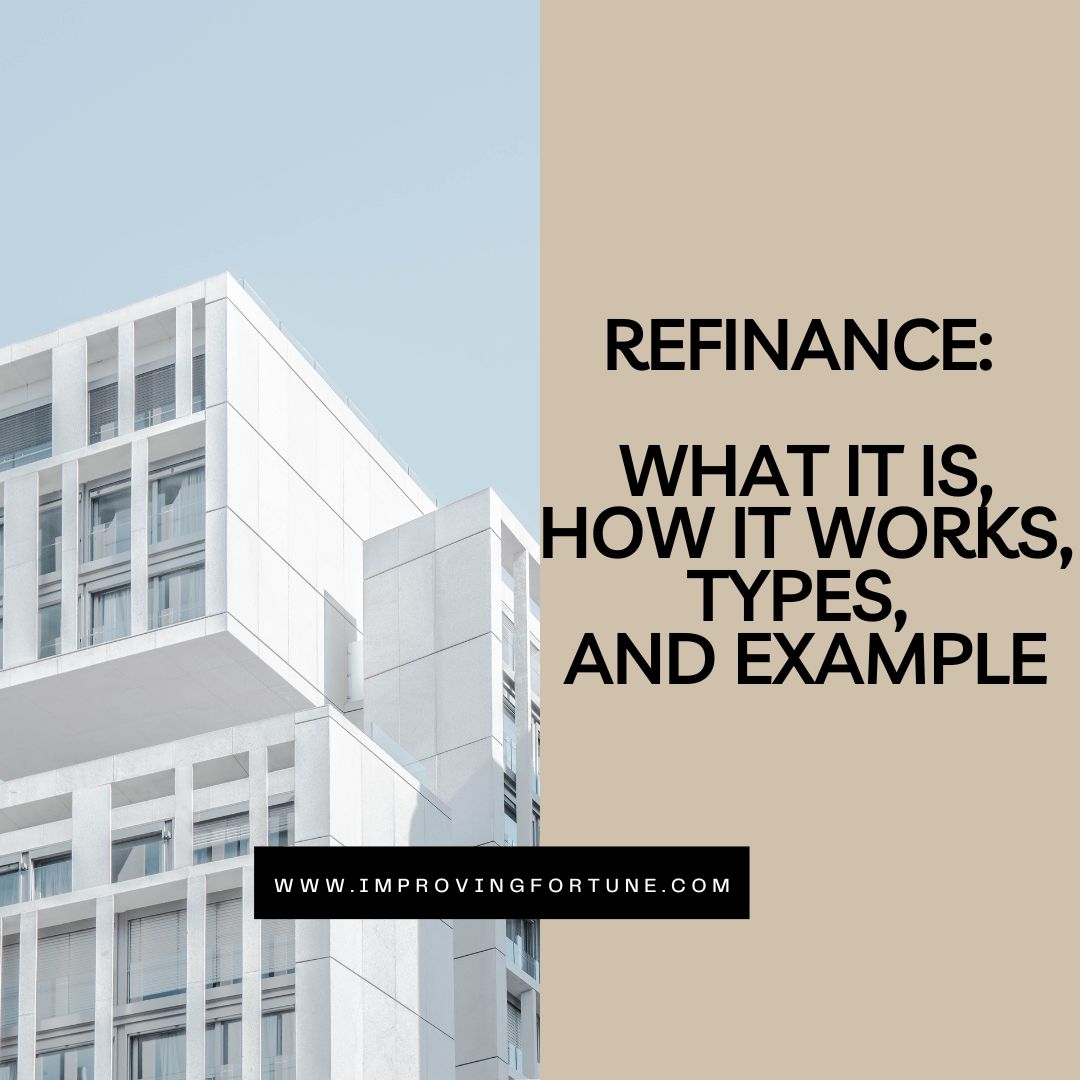Refinance: What It Is, How It Works, Types, and Example
Are you considering refinancing your mortgage but don’t necessarily know what it entails? Refinancing can seem like a daunting process, but it doesn’t have to be. By understanding the basics of what it is, how it works, and the different types available, you can make informed decisions about whether refinancing is right for you. In this blog post, we’ll explore the ins and outs of refinancing so that you have a solid understanding of the topic. Let’s dive in!
Refinance: What It Is, How It Works, Types, and Example
Refinancing is the process of taking out a new loan to replace an existing one. This may be done to get a lower interest rate, extend the loan term, or change the type of loan. Refinancing can provide many benefits, but it’s important to understand the process and types of loans available to make an informed decision.
Refinancing is a term that’s used a lot in personal finance circles, but what does it actually mean? Essentially, refinancing is the process of taking out a new loan to replace an existing one. This can be a smart move for many people, especially if you can get a better interest rate or payment terms.There are many reasons why one might consider refinancing. For example, if interest rates have dropped since you first took out your loan, you may be able to refinance for a lower rate, which could save you money over the life of the loan. Alternatively, you may have originally taken out a loan with an adjustable interest rate, but now want to switch to a fixed rate to gain more stability and predictability in your payments.
Another reason why people refinance is to shorten the length of their loan. For example, you may have originally taken out a 30-year mortgage, but now want to switch to a 15-year mortgage to pay off your home faster and save on interest payments.
Overall, the goal of refinancing is to save money and/or improve your financial situation in some way. However, it’s important to note that refinancing comes with costs of its own, such as closing costs and fees. Therefore, it’s important to carefully weigh the pros and cons of refinancing before making a decision.
If you’re considering refinancing, there are a few things you can do to increase your chances of success. Start by shopping around and comparing different lenders to find the best interest rate and terms for your situation. You should also have a thorough understanding of your credit score and financial situation, as these factors can impact your ability to get approved for a refinance.
Refinancing can be a powerful tool for improving your financial situation, but it’s important to approach it with caution and carefully consider all of your options. With the right approach and a little bit of research, you may be able to save money and achieve your financial goals through the process of refinancing.
How it Works
When you refinance, you’re essentially replacing your existing loan with a new one. To do this, you’ll need to go through the same process as when you originally obtained your loan. This includes providing documentation such as income verification and credit history, and undergoing a credit check.
The lender will then evaluate your application, and if approved, provide you with a new loan offer. You’ll need to review the terms carefully and make sure they meet your financial goals. Once you accept the new loan, the funds will be used to pay off your existing loan, and you’ll begin making payments on the new loan.
When it comes to managing finances, there are several tools and strategies that individuals can employ to better control their spending and optimize their investment opportunities. One such strategy is refinancing, which essentially refers to the process of replacing an existing loan or debt obligation with a new one with more favorable terms.Refinancing can be a wise decision for individuals who are looking to save money, reduce their monthly payments, or pay off their debts faster. In this article, we will explore the basics of how refinancing works, as well as how you can determine if it is the right option for your specific financial situation.
Refinancing is most commonly associated with mortgages, as homeowners may choose to refinance their home loans in order to take advantage of lower interest rates or better loan terms. However, refinancing is not limited solely to mortgages – individuals may also refinance auto loans, personal loans, or debts owed on credit cards.
The process of refinancing is fairly straightforward. Essentially, you will apply for a new loan that will pay off the existing loan. The new loan will have different terms, potentially including a lower interest rate, a shorter repayment period, or different monthly payments. Once the new loan is approved and disbursed, you will begin making payments on the new loan instead of the old one.
One key factor to keep in mind when considering refinancing is that it is not always a guaranteed solution. In order to qualify for a new loan, you will need to meet certain criteria related to your credit score, income, and debts owed. Additionally, refinancing may not be the best option for individuals who are close to paying off their existing debts, as the cost of refinancing may ultimately outweigh any potential savings.
That being said, refinancing can be an effective way to save money over the long term, particularly if you are able to secure a lower interest rate or shorter repayment period. If you are considering refinancing but are not sure if it is the right decision for you, it can be helpful to speak with a financial advisor or loan officer who can guide you through the process and help you determine if refinancing is the best fit for your financial goals.
Refinancing can be a powerful tool for individuals who are looking to save money, reduce their monthly payments, or pay off their debts sooner. With careful consideration and attention to your individual financial circumstances, refinancing can help you to better manage your finances and achieve your long-term financial goals.
Reasons Why People Refinance
People refinance for several reasons. The most common reasons include:
- Lower Interest Rates
If interest rates have dropped since you took out your mortgage, refinancing could save you significant amounts of money. Lower interest rates could also decrease your monthly mortgage payments, which could free up some money for other expenses.
- Changing Mortgage Terms
Homeowners may refinance if they’re struggling to make their current mortgage payments. By refinancing, you could extend the term of your mortgage, which reduces your monthly payments.
- Access to Cash
Refinancing your home may give you access to cash that you could use for other purposes, such as home renovations, paying off debts, or investing in other areas.
Types of Refinancing
There are several types of refinancing. Here are some of the most common:
- Rate-and-Term Refinance
A rate-and-term refinance is the most common type of refinancing. It’s also known as a “no-cash” refinance or a “limited-cash” refinance because you only get enough money to cover the closing costs.
The objective of a rate-and-term refinance is to get a better interest rate or change the terms of your mortgage without taking cash out. For instance, you may choose to shorten or extend the duration of your mortgage term based on your financial situation.
Refinancing is one of the most popular ways homeowners can save money and optimize their mortgage. There are different types of refinancing options available, and one popular option is the “rate-and-term” refinance. A rate-and-term refinance is when a homeowner replaces their current mortgage with a new one, with the same principal amount but with different terms or rates. In this article, we will explore the ins and outs of rate-and-term refinancing.First of all, let’s clarify what refinancing is. Basically, refinancing is the process of replacing an existing mortgage with a new one. The new mortgage typically has different rates, terms, and conditions, which can save homeowners money or help them achieve their financial goals.
There are a few different types of refinancing options available, including cash-out refinancing, where homeowners can take equity out of their home, and rate-and-term refinancing, which we’ll discuss in more detail. Rate-and-term refinancing involves replacing the current mortgage with a new one but keeping the same principal amount.
The main benefits of a rate-and-term refinance are lower interest rates, shorter loan duration, and lower monthly payments. With a lower interest rate, you can save money over the life of the loan and potentially pay off the mortgage quicker. For homeowners who are looking to reduce their monthly mortgage payments, a rate-and-term refinance can also be a great option. By extending the mortgage duration, you can reduce your monthly payment.
Another benefit of rate-and-term refinancing is the ability to switch between different types of mortgages. For example, if you currently have an adjustable-rate mortgage, you may be able to switch to a fixed-rate mortgage to have the security of a fixed interest rate for the duration of the loan.
But before you decide to go for a rate-and-term refinance, there are a few things to consider. One important factor is the closing costs associated with refinancing. Closing costs can add up to several thousand dollars, so it’s important to factor them into the overall cost-benefit analysis. In some cases, homeowners may be able to negotiate a no-closing-cost refinance, but this usually comes with a slightly higher interest rate.
Another factor to consider is your level of equity in the home. If you have very little equity, you may not be able to refinance at the best interest rates, or you may not be approved at all. In contrast, if you have a lot of equity, you may be able to take advantage of cash-out refinancing to access the equity in your home.
Rate-and-term refinancing can be a great option for homeowners who want to save money, pay off their mortgage quicker, or achieve their financial goals. However, it’s important to consider closing costs, equity levels, and other factors before making a decision. If you’re interested in exploring your refinancing options, your lender can help you determine if rate-and-term refinancing is a good choice for you.
- Cash-Out Refinance
A cash-out refinance enables you to access the equity in your home and convert it into cash. Homeowners typically use this type of refinancing to consolidate high-interest credit card debt, pay for home renovations, or invest in other profitable ventures.
If you choose to go for cash-out refinancing, you’ll receive a new mortgage with a higher principal balance that includes the amount you want to cash out.
- Streamline Refinance
A streamline refinance is a type of refinance that’s commonly used for Federal Housing Administration (FHA) mortgages. The good thing about this type of refinancing is that you can qualify even if your home has declined in value.
Streamline refinancing enables you to get a lower interest rate, change your loan terms, or switch from an adjustable-rate mortgage to a fixed-rate mortgage. The goal of this type of refinancing is to make the process as quick and easy as possible by minimizing paperwork and eliminating vetting requirements.
Bottom Line
Refinancing may be an excellent way to improve your overall financial well-being. Consider the various types of refinancing and determine which one works best for your situation. Make sure you do your research, including shopping around for the best interest rates and consulting with a professional mortgage expert.
Example
Let’s say you currently have a $200,000 mortgage at a 5% interest rate with 25 years left on the term. You’ve been making payments for five years and have paid off $20,000 of your mortgage loan. You could choose to refinance your mortgage loan with a new 30-year term at a 4% interest rate.
The new loan would have a balance of $180,000 ($200,000 original balance minus $20,000 paid). The new monthly payment would be lower, and you would have an additional five years to pay off the loan. However, keep in mind that extending the term of your loan means you’ll ultimately pay more in interest.
In conclusion, refinancing can be a helpful financial tool if you’re looking to save money or improve your financial situation. Consider your options carefully, and work with a reputable lender to find a loan that meets your needs.






